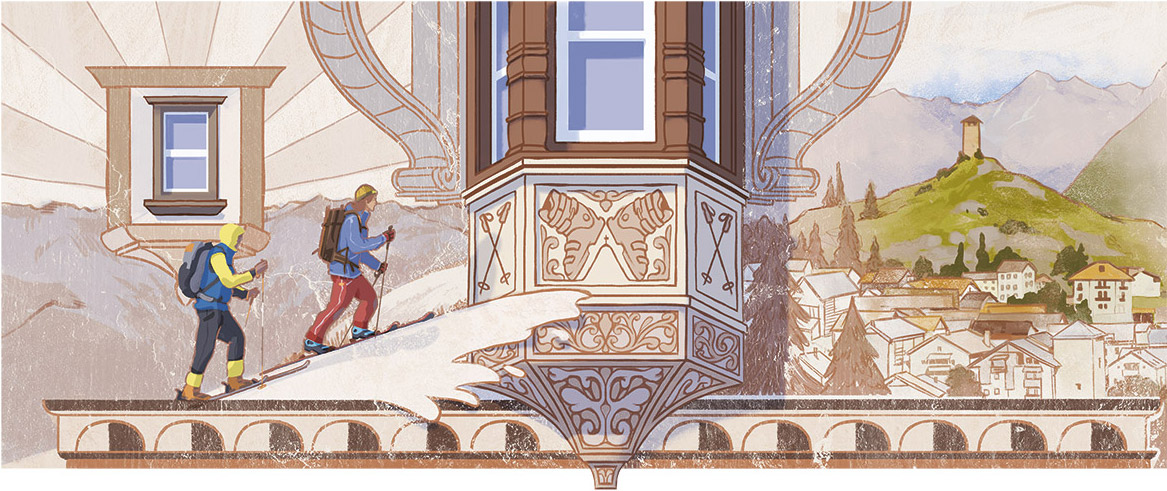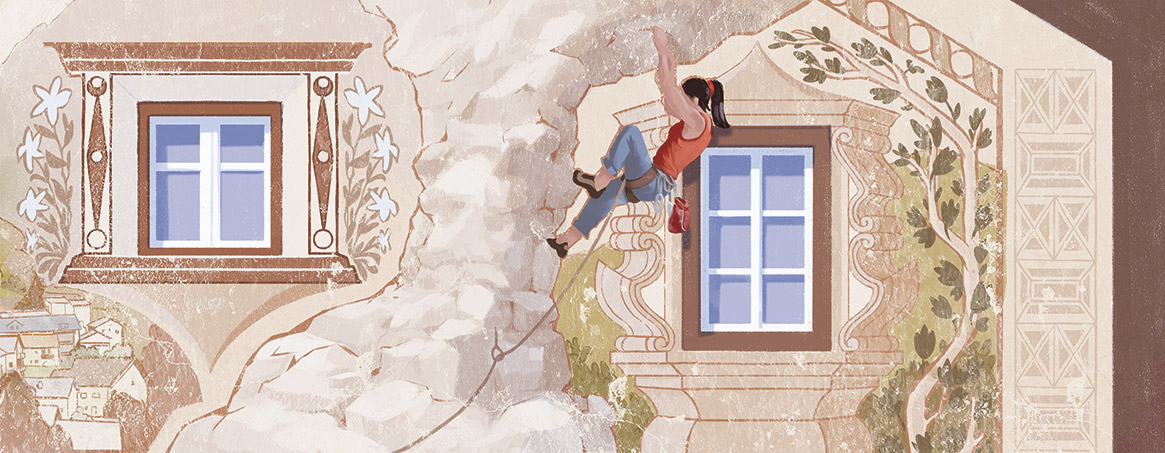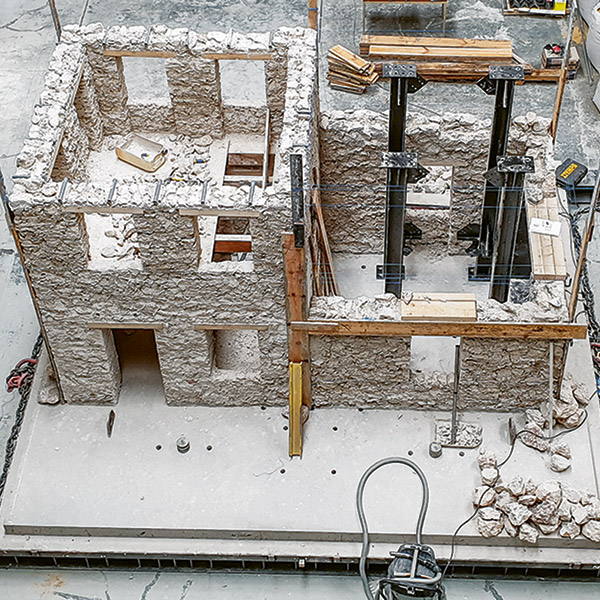Feature: The tourism of the future
There is strength in preserving beauty
Snow’s becoming scarce, most mountain railways are no longer profitable, and sustainable business models remain unfeasible for many destinations. The Lower Engadin and Val Müstair are exceptions. We take a look on the spot.

The sgraffiti on the houses of Ardez reflect our modern notions of what is idyllic and authentic. | Illustration: Nico Kast
It’s early December, and we’re in Ardez in the Lower Engadin, at 1,467 metres above sea level. Over half a metre of snow has fallen in the past few days, and anyone getting off the train here on this glorious Thursday afternoon will sink to their knees in it. When the mountain railway in Scuol starts the winter season two days from now, five miles to the east, of us, it’ll have perfect conditions. Ardez is a village of some 400 inhabitants that boasts houses in the Engadin style dating back to the 16th and 17th centuries. It has an enchanting view of the snow-covered peaks of the canton of Graubünden.
Things don’t ever get too hectic here, not even during the lucrative Christmas season, because it’s got no mountain railway, no après-ski tepees, no Jacuzzis, oyster bars or shopping areas. There’s just a mobile children’s ski lift that’s installed on the outskirts of the village every December. When people come here for their holidays, it’s usually for ski tours, snowshoeing, hiking or climbing.
Roger Schorta runs the Hotel Alvetern in the heart of the village. “We’ve never experienced here just how much money a mountain railway can bring”, he says. But he prefers it that way, and emphasises the village’s long tradition of preserving its history. “Just look at the centre of our village. Nobody would ever think of demolishing any of our historic houses here”. This is precisely why people come, he says. And also because of its unique landscape. “Our guests walk through the village of an evening, they enjoy the incredible tranquillity we offer and feel the power of the mountains around us”, he says. Ardez has no plans to start offering anything more: “We want to preserve this tranquillity”.
But there aren’t many people dependent on winter tourism who are currently as relaxed and confident as Schorta. “It’s medium-sized areas below 2,000 metres with a mountain railway that are having a particularly hard time”, says Monika Bandi, who’s the head of the Tourism Research Unit at the University of Bern. Ski resorts such as Aletsch, Saanenland, Meiringen, Sörenberg and Melchsee-Frutt are seeing their livelihood melt away: “Some resorts now invest around 50 percent of their total energy in creating artificial snow”.
Will mountain railways soon be a public service?
The climate crisis is having drastic consequences for Alpine tourism. Since measurements began in 1864, average temperatures in Switzerland have risen by some two degrees Celsius. It’s the higher altitudes that are especially affected. The frost line has already shifted upwards by 300 to 400 metres. Meteorologists are registering fewer snowy days in winter, and more rainy days. The snowfall below 800 metres has decreased by 50 percent, and above 2,000 metres by 20 percent. Simulations carried out by the federal government have shown that by 2035, depending on the emissions scenario and altitude, the winter season in the Alps could begin half a month to one month later, and end one to three months earlier.
“The profitability of winter sports destinations is declining almost everywhere”, says Bandi. “Today, 50 to 70 percent of the mountain railways barely make any profit and can no longer finance investments themselves”. Many can only be maintained thanks to subsidies from the federal government, the cantons and municipalities, or through private donations. The question is being increasingly asked whether mountain railways should become a public service funded by the taxpayer. “For many regions, the mountain railways are simply ‘too big to fail’ because an entire economic ecosystem is dependent on them”, says Bandi. Whether it’s hotels, ski schools, village shops or restaurants, they all depend on the mountain railways. That’s particularly true of the property market, because a chalet with a mountain railway connection is worth significantly more than one without. As a result, many destinations are using subsidies to keep intact infrastructure that has in fact long since ceased to be profitable, let alone sustainable.
In 2021, with an eye on climate change, Bandi wrote a report on the strategic options for tourism in the year 2030. It showed how many destinations find themselves in a vicious circle. Uncertain snow conditions are making people hesitate to book their winter sports, while warm weather and less snow are shortening the season. Fewer guests are coming, running things is becoming more expensive, and this is putting pressure on income. This is why investments in sustainable transformation are often just not materialising. “In our investigation, we saw how many destinations have started to invest in adapting to climate change”, says Bandi. Such as by funding new avalanche defences, stabilising hillsides, and creating rainwater retention basins. But the situation is very different when it comes to mitigation – in other words, reducing the emissions caused by tourism. “We are still deep in the red in this regard”. It’s long been clear where the biggest problem is: “50 to 75 percent of total emissions in tourism are generated on arrival and departure”. If tourism is to be more sustainable, regulations are going to be needed, such as a paraffin tax.
From national park to duty-frees
If you ask experts who are the pioneers in sustainable Alpine tourism, you’ll inevitably be told about the Lower Engadin and Val Müstair. ‘Engadin Scuol Samnaun Val Müstair Tourism Ltd’, usually known by its German acronym TESSVM, is responsible for marketing five municipalities of the Lower Engadin. For ten years now, its focus has been on environmental responsibility. It’s the only Swiss destination that’s certified by Tourcert, the strictest German tourist label in the fields of sustainability and corporate responsibility. TESSVM has furthermore received the highest award for sustainability from ‘Switzerland Tourism’. The region also boasts the first-ever national park in the Alps, founded in 1914, which is a powerful advertisement for nature conservation. But TESSVM also includes a town that would seem to represent the antithesis of this: Samnaun, which is linked with the town of Ischgl just across the border in Austria, and which has made a name for itself as a bustling ski resort and a duty-free enclave.
According to Sven Berchtold, the sustainability officer for TESSVM, the ‘Sustainability Council’ is an important instrument for further development in the region. Every six months, 25 representatives from the mountain railways, cultural organisations, municipalities, hotels and business come together to determine the measures that are necessary for the region – such as offering more regional products in its restaurants. Dialogue is the order of the day. This is also why the Council is in close contact with the foundation Pro Terra Engiadina, which is committed to protecting the landscapes of the Lower Engadin. Their aim is to prevent the conflict between nature conservation and tourism that elsewhere has led to turf wars.
Authenticity label
“The Lower Engadin is a pioneer in sustainable Alpine tourism”, says Stefan Forster, who’s a professor at the Institute of Natural Resource Sciences at the Zurich University of Applied Sciences (ZHAW). His research group is based at the ‘Center da Capricorns’ near the Beverin Nature Park and works closely with practical partners including some from outside the canton of Graubünden. “In tourism, the landscape is our capital. Our surveys have shown that it’s of central importance to guests”, says Forster. “But all the same, many tourist destinations still assign too little significance to the value of the landscape in their strategic considerations”. Forster and his team are also developing concepts to reduce the dependence on snow in tourist centres – e.g., by expanding their cultural programmes, as in the case with the “Klangwelt” music experience organised in the Toggenburg.

Seven years ago, Forster also brought the ‘Mountaineering Villages Initiative’ to the Lower Engadin. This is an international endeavour of the Alpine associations of Austria, Germany, Italy, Slovenia and Switzerland (SAC) that takes its cue from the Alpine Convention (the world’s first-ever international treaty for protecting a mountain region). These Mountaineering Villages feature intact landscapes, a harmonious townscape, living traditions and a lot of Alpine expertise – in other words, considerable knowledge about mountain sports. A detailed catalogue defines what developments are permitted or prohibited.
Forster’s group carried out a preliminary study about bringing the concept to Switzerland. They helped to prepare the necessary documentation, and drew in students who were writing their Bachelor and Master theses. “In the Mountaineering Villages Initiative, we developed the basis for bringing such alternative offerings out of their niche in the medium term”, he says. “Proposals such as this can create new images to guide people’s actions. These can become image bearers for bigger destinations”. Today, there are some 38 such Mountaineering Villages in the Alps, of which two are in Switzerland: Lavin and Guarda & Ardez (which lie two miles apart, but for the purposes of the Initiative are considered as a single village).
The Hotel Alvetern in Ardez is one of eight partner establishments of the Mountaineering Villages. Its manager, Roger Schorta, says: “I don’t normally have a high opinion of labels. But this one fits in perfectly with our philosophy”. A few days ago, a guest mentioned the label and asked what innovations were being planned. “None”, said Schorta. “The point of it is to preserve what we’ve already got”.




